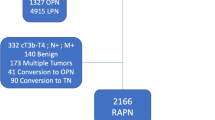Abstract
The background of the study was to examine potential causes for a positive surgical margin (PSM) and develop strategies to improve surgical outcomes. A retrospective review of consecutive partial nephrectomy cases for renal cell carcinoma was performed. We divided the patients into 2 groups. The first group consisted of the first 67 renal tumors in 65 patients that underwent our early surgical technique. The second group consisted of the next 45 renal tumors in 39 patients that underwent the revised surgical technique which included wider resections and robotically controlled ultrasound. Our primary outcome was margin status and secondary outcome was disease recurrence. Univariate and multivariate analyses were performed to determine factors that resulted in a PSM. Positive margins were detected in 19 out of 67 (28 %) renal tumors in the early technique group compared to 1 out of 45 (2 %) positive margins in the revised technique group (p < 0.001). On multivariate analysis, only technique modification (OR 0.04, p = 0.003) and larger tumor size (OR 0.41, p = 0.01) were significant predictors of a lower rate of PSM. Smaller tumors were more common in robotic assisted partial nephrectomies which had a higher rate of PSM on univariate analysis (OR 3.51, p = 0.04). Only one patient with a PSM experienced a systemic disease recurrence. In our experience, self-assessment and technique modification resulted in a dramatic PSM improvement. Smaller tumors were associated with PSM. It is important for all surgeons to periodically look at their own surgical outcomes and modify their surgical technique accordingly.
Similar content being viewed by others
References
Go AS, Chertow GM, Fan D, McCulloch CE, Hsu CY (2004) Chronic kidney disease and the risks of death, cardiovascular events, and hospitalization. N Engl J Med 351:1296–1305
Huang WC, Elkin EB, Levey AS, Jang TL, Russo P (2009) Partial nephrectomy versus radical nephrectomy in patients with small renal tumors—is there a difference in mortality and cardiovascular outcomes? J Urol 181:55–62
Campbell SC, Novick AC, Belldegrun A, Blute ML, Chow GK, Derweesh IH, Faraday MM, Kaouk JH, Leveillee RJ, Matin SF (2009) Guideline for management of the clinical T1 renal mass. J Urol 182:1271–1279
Kim SP, Shah ND, Weight CJ, Thompson RH, Moriarty JP, Shippee ND, Costello BA, Boorjian SA, Leibovich BC (2011) Contemporary trends in nephrectomy for renal cell carcinoma in the United States: results from a population based cohort. J Urol 186:1779–1785
Marszalek M, Carini M, Chlosta P, Jeschke K, Kirkali Z, Knuchel R, Madersbacher S, Patard JJ, Van Poppel H (2012) Positive surgical margins after nephron-sparing surgery. Eur Urol 61:757–763
Yossepowitch O, Thompson RH, Leibovich BC, Eggener SE, Pettus JA, Kwon ED, Herr HW, Blute ML, Russo P (2008) Positive surgical margins at partial nephrectomy: predictors and oncological outcomes. J Urol 179:2158–2163
Bensalah K, Pantuck AJ, Rioux-Leclercq N, Thuret R, Montorsi F, Karakiewicz PI, Mottet N, Zini L, Bertini R, Salomon L et al (2010) Positive surgical margin appears to have negligible impact on survival of renal cell carcinomas treated by nephron-sparing surgery. Eur Urol 57:466–471
Bernhard JC, Pantuck AJ, Wallerand H, Crepel M, Ferriere JM, Bellec L, Maurice-Tison S, Robert G, Albouy B, Pasticier G et al (2010) Predictive factors for ipsilateral recurrence after nephron-sparing surgery in renal cell carcinoma. Eur Urol 57:1080–1086
Kwon EO, Carver BS, Snyder ME, Russo P (2007) Impact of positive surgical margins in patients undergoing partial nephrectomy for renal cortical tumours. BJU Int 99:286–289
Permpongkosol S, Colombo JR Jr (2006) Gill IS and Kavoussi LR: Positive surgical parenchymal margin after laparoscopic partial nephrectomy for renal cell carcinoma: oncological outcomes. J Urol 176:2401–2404
Uzzo RG, Novick AC (2001) Nephron sparing surgery for renal tumors: indications, techniques and outcomes. J Urol 166:6–18
Sutherland SE, Resnick MI, Maclennan GT, Goldman HB (2002) Does the size of the surgical margin in partial nephrectomy for renal cell cancer really matter? J Urol 167:61–64
Minervini A, di Cristofano C, Lapini A, Marchi M, Lanzi F, Giubilei G, Tosi N, Tuccio A, Mancini M, della Rocca C et al (2009) Histopathologic analysis of peritumoral pseudocapsule and surgical margin status after tumor enucleation for renal cell carcinoma. Eur Urol 55:1410–1418
Mottrie A, De Naeyer G, Schatteman P, Carpentier P, Sangalli M, Ficarra V (2010) Impact of the learning curve on perioperative outcomes in patients who underwent robotic partial nephrectomy for parenchymal renal tumours. Eur Urol 58:127–132
Raz O, Mendlovic S, Shilo Y, Leibovici D, Sandbank J, Lindner A, Zisman A (2010) Positive surgical margins with renal cell carcinoma have a limited influence on long-term oncological outcomes of nephron sparing surgery. Urology 75:277–280
Sundaram V, Figenshau RS, Roytman TM, Kibel AS, Grubb RL 3rd, Bullock A, Benway BM, Bhayani SB (2011) Positive margin during partial nephrectomy: does cancer remain in the renal remnant? Urology 77:1400–1403
Cevasco M, Ashley SW (2011) Quality measurement and improvement in general surgery. Perm J 15:48–53
Wang TT, Ahmed K, Khan MS, Dasgupta P (2012) Quality-of-care framework in urological cancers: where do we stand? BJU Int 109:1436–1443
Birkmeyer JD, Shahian DM, Dimick JB, Finlayson SR, Flum DR, Ko CY, Hall BL (2008) Blueprint for a new American College of Surgeons: National surgical quality improvement program. J Am Coll Surg 207:777–782
Mitropoulos D, Artibani W, Graefen M, Remzi M, Roupret M (2012) Truss M and European Association of Urology Guidelines P: Reporting and grading of complications after urologic surgical procedures: an ad hoc EAU guidelines panel assessment and recommendations. Eur Urol 61:341–349
Conflict of interest
Dr. Igor Sorokin, Dr. Michael A. Feuerstein, Dr. Paul Feustel, and Dr. Ronald P. Kaufman Jr. declare that they have no conflict of interest.
Informed consent
For this type of study formal consent is not required.
Author information
Authors and Affiliations
Corresponding author
Rights and permissions
About this article
Cite this article
Sorokin, I., Feuerstein, M.A., Feustel, P. et al. Self-assessment of surgical technique leads to reduction of positive surgical margins in partial nephrectomy. J Robotic Surg 9, 45–50 (2015). https://doi.org/10.1007/s11701-014-0485-9
Received:
Accepted:
Published:
Issue Date:
DOI: https://doi.org/10.1007/s11701-014-0485-9




